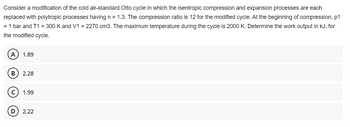
Elements Of Electromagnetics
7th Edition
ISBN: 9780190698614
Author: Sadiku, Matthew N. O.
Publisher: Oxford University Press
expand_more
expand_more
format_list_bulleted
Question
thumb_up100%
Consider a modification of the cold air-standard Otto cycle in which the isentropic compression and expansion processes are each replaced with polytropic processes having n = 1.3. The compression ratio is 12 for the modified cycle. At the beginning of compression, p1 = 1 bar and T1 = 300 K and V1 = 2270 cm3. The maximum temperature during the cycle is 2000 K. Determine the work output in kJ, for the modified cycle.

Transcribed Image Text:Consider a modification of the cold air-standard Otto cycle in which the isentropic compression and expansion processes are each
replaced with polytropic processes having n = 1.3. The compression ratio is 12 for the modified cycle. At the beginning of compression, p1
= 1 bar and T1 = 300 K and V1 = 2270 cm3. The maximum temperature during the cycle is 2000 K. Determine the work output in kJ, for
the modified cycle.
A 1.89
B 2.28
с 1.99
D 2.22
Expert Solution
This question has been solved!
Explore an expertly crafted, step-by-step solution for a thorough understanding of key concepts.
This is a popular solution
Trending nowThis is a popular solution!
Step by stepSolved in 2 steps with 1 images

Knowledge Booster
Learn more about
Need a deep-dive on the concept behind this application? Look no further. Learn more about this topic, mechanical-engineering and related others by exploring similar questions and additional content below.Similar questions
- A four-cylinder, two-stroke 2.4-L diesel engine that operates on an ideal Diesel cycle has a compression ratio of 22 and a cutoff ratio of 1.8. Air is at 70°C and 97 kPa at the beginning of the compression process. Using the cold-airstandard assumptions, determine how much power the engine will deliver at 4250 rpm.arrow_forwardAn air standard Otto cycle at the start of the isentropic compression has P₁ = 100 kPa and T₁ = 27°C. The compression ratio is 10 and during the heat addition process 1000 kJ/kg are supplied. Using the cold air standard analysis method, the net work for this cycle is most nearly equal to: A. 960 kJ/kg B. 900 kJ/kg C. 602 kJ/kg D. 333 kJ/kg E. Cannot be determined with the given informationarrow_forward
Recommended textbooks for you
 Elements Of ElectromagneticsMechanical EngineeringISBN:9780190698614Author:Sadiku, Matthew N. O.Publisher:Oxford University Press
Elements Of ElectromagneticsMechanical EngineeringISBN:9780190698614Author:Sadiku, Matthew N. O.Publisher:Oxford University Press Mechanics of Materials (10th Edition)Mechanical EngineeringISBN:9780134319650Author:Russell C. HibbelerPublisher:PEARSON
Mechanics of Materials (10th Edition)Mechanical EngineeringISBN:9780134319650Author:Russell C. HibbelerPublisher:PEARSON Thermodynamics: An Engineering ApproachMechanical EngineeringISBN:9781259822674Author:Yunus A. Cengel Dr., Michael A. BolesPublisher:McGraw-Hill Education
Thermodynamics: An Engineering ApproachMechanical EngineeringISBN:9781259822674Author:Yunus A. Cengel Dr., Michael A. BolesPublisher:McGraw-Hill Education Control Systems EngineeringMechanical EngineeringISBN:9781118170519Author:Norman S. NisePublisher:WILEY
Control Systems EngineeringMechanical EngineeringISBN:9781118170519Author:Norman S. NisePublisher:WILEY Mechanics of Materials (MindTap Course List)Mechanical EngineeringISBN:9781337093347Author:Barry J. Goodno, James M. GerePublisher:Cengage Learning
Mechanics of Materials (MindTap Course List)Mechanical EngineeringISBN:9781337093347Author:Barry J. Goodno, James M. GerePublisher:Cengage Learning Engineering Mechanics: StaticsMechanical EngineeringISBN:9781118807330Author:James L. Meriam, L. G. Kraige, J. N. BoltonPublisher:WILEY
Engineering Mechanics: StaticsMechanical EngineeringISBN:9781118807330Author:James L. Meriam, L. G. Kraige, J. N. BoltonPublisher:WILEY

Elements Of Electromagnetics
Mechanical Engineering
ISBN:9780190698614
Author:Sadiku, Matthew N. O.
Publisher:Oxford University Press

Mechanics of Materials (10th Edition)
Mechanical Engineering
ISBN:9780134319650
Author:Russell C. Hibbeler
Publisher:PEARSON

Thermodynamics: An Engineering Approach
Mechanical Engineering
ISBN:9781259822674
Author:Yunus A. Cengel Dr., Michael A. Boles
Publisher:McGraw-Hill Education

Control Systems Engineering
Mechanical Engineering
ISBN:9781118170519
Author:Norman S. Nise
Publisher:WILEY

Mechanics of Materials (MindTap Course List)
Mechanical Engineering
ISBN:9781337093347
Author:Barry J. Goodno, James M. Gere
Publisher:Cengage Learning

Engineering Mechanics: Statics
Mechanical Engineering
ISBN:9781118807330
Author:James L. Meriam, L. G. Kraige, J. N. Bolton
Publisher:WILEY